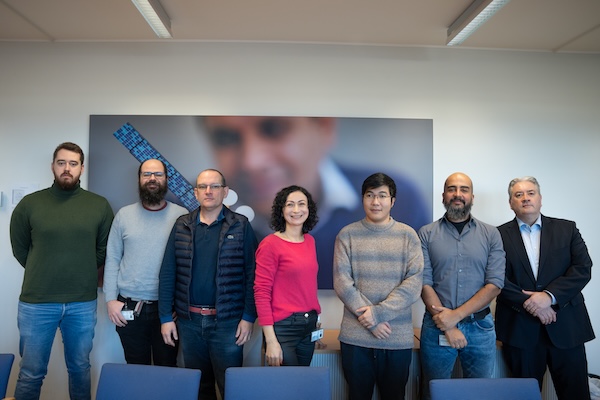 AITAX13 project team;
Credit: Ali Sahib, Chronicle.lu
AITAX13 project team;
Credit: Ali Sahib, Chronicle.lu
Led by the University of Luxembourg, assisted by the Luxembourg School of Business, and financially supported by the Luxembourg National Research Fund (FNR), the AITAX13 project has designed and built a tool to assist tax function leaders in large multinational entities (MNE), industry analysts, tax advisors (Finance, Audit & Legal) and international government agencies in complying with the reporting requirements of Action Plan 13 - a global initiative established in 2013 aimed at providing enhanced transparency for tax administration.
As part of FNR’s JUMP programme, a competitive funding instrument which is designed to bridge the technical and funding gap between research-driven discoveries and their commercialisation/utilisation, the University of Luxembourg secured €300,000 in funding for the development of its AITAX13 project; bringing on board an “Entrepreneur in Residence” to provide real world knowledge of regulatory requirements. This additional resource helped transform their academical developments into real world application(s), such as the AITAX13 website, which is designed to provide assistance in complying with the aforementioned tax reporting regulations.
For the AITAX13 website, the project team at the University of Luxembourg have utilised Machine Learning and Artificial Intelligence (AI) to compile the world's largest, publicly-available knowledge database of public Country-by-Country Tax Reporting. This data set, combined with a web-based dashboard, allows users to create a factsheet of results by selecting from a list of MNEs, industries and years of operation. The dashboard then takes these parameters and using AI provides a detailed breakdown of an MNE’s headcount, effective tax rates, revenue, profits and net margin by location. This data can also be used to create comparisons against various MNEs.
Ordinarily, this kind of analysis would require many man hours to compile but the AITAX13 tool’s use of Machine Learning and AI allows this data to be processed quickly, providing accurate and discernible results with just a few clicks.
On Monday 13 January 2025, Chronicle.lu spoke with Jorge Augusto Miera, a research scientist at the University of Luxembourg involved in the development of the AITAX13 tool.
Chronicle.lu: What are the benefits of the involvement of the FNR JUMP programme?
Jorge Augusto Meira: The JUMP programme allowed us to take our development and knowledge of Machine Learning and Artificial Intelligence and bring it into the real world through the development of this tool. The funding from the JUMP project meant we could fund the onboarding of an Entrepreneur in Residence, in this case Ken O’Mahoney, to assist in the transition from academia to real world use. His input helped us to take our technological knowledge and apply it accurately to the requirements of the regulatory reporting. We could then develop a system which makes the results accessible and advantageous for the general public.
Chronicle.lu: How challenging has this project has been for those involved?
Jorge Augusto Meira: To create a product from these technologies required a lot of interaction with various experts both in the technical and the tax domains. Communication was key. Ensuring that we utilised the same language and terminology was challenging but, once established and understood, we could tailor our technology to meet the requirements on the tax side; mainly how to compile, store and present the information in an accurate and accessible way. Interaction between all the team members was crucial to be able to move from a proof of concept to a real world product.
Chronicle.lu: What are the teams’ hopes in terms of adoption of the service?
Jorge Augusto Meira: Standards in this market are understandably very high but we believe that we have developed something amazing for multinationals, fund managers and tax authorities to use. By using historical analysis of public data in a smart and intuitive way, and by incorporating Machine Learning, we have designed and built a system which can be used to not only look at historical tax data in a new way but to also identify potential future problems for multi-nationals. Regulators can now quickly analyse a volume of data they would have struggled with in the past. Our expectations for this product are very high.
Chronicle.lu: What are your thoughts on public scepticism in regards to the veracity of results produced by already existing AI systems?
Jorge Augusto Meira: People are rightly sceptical and judgemental. The advantage for us is that we are able to use real world historic data to show the accuracy and reliability of our system, and from this we can build trust. As we collect more data this will only improve further.
Chronicle.lu: What comes next?
Jorge Augusto Meira: The spin-off to the next phase is forecasting. We envisage that MNEs can use the tool to create forecasts. As our database grows, the analysis of that historic data can be used to forecast future problems, allowing MNEs to identify problems and make decisions before they arise. More data, combined with the power of our machine learning tools, equals better and more accurate analysis and forecasting. But this also requires an element of trust in the system and trust is built from explanations of what the data shows. Our tool is very focussed on causality and providing concise explanations of the data being presented.
With this in mind, the project team is currently inviting large multi-nationals to utilise and help improve the product after the launch of the AITAX13 website (which took place on Tuesday 14 January 2025).








